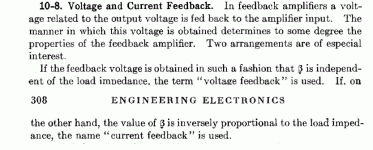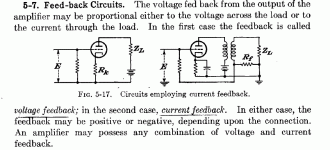Independently of the way in that the active component choiced receives the feedback signal, the important is that current feedback in its only meaning implies to feed back a sample of the current flowing though the load. Any other interpretation of this fact is verse.
Jan, Putting a cap across Rg will have exactly the opposite effect and make gain flatness worse up to the point were eventually the thing will start oscillating.Hans what do you think, putting Cg across Rg instead of to gnd, would that not be better?
Jan
Hans
Independently of the way in that the active component choiced receives the feedback signal, the important is that current feedback in its only meaning implies to feed back a sample of the current flowing though the load. Any other interpretation of this fact is verse.
What is your justification for this claim?
We hear what you are saying but you are talking about CC output, totally different to CFB.Independently of the way in that the active component choiced receives the feedback signal, the important is that current feedback in its only meaning implies to feed back a sample of the current flowing though the load. Any other interpretation of this fact is verse.
Dan.
F. E. Terman, Engineering Electronics: Clearer impossible.
I'm well aware of the historical usage of this term. Tell me, please, in the case of "current feedback", the path of the current being referred to - to what/where is the subject current being fed back?
Anothe example: Seely.
Never has been mentioned the magnitude of the amplifier receives, only in the manner it is taken from the output. This gives origin to the 4 mode of feedback an amplifier: Current-current, voltage-voltage, current-voltage and voltage-current, or in other words; voltage, transimpedance, transconductance or simply current amplifier.
Never has been mentioned the magnitude of the amplifier receives, only in the manner it is taken from the output. This gives origin to the 4 mode of feedback an amplifier: Current-current, voltage-voltage, current-voltage and voltage-current, or in other words; voltage, transimpedance, transconductance or simply current amplifier.
Attachments
Anothe example: Seely.
Never has been mentioned the magnitude of the amplifier receives, only in the manner it is taken from the output. This gives origin to the 4 mode of feedback an amplifier: Current-current, voltage-voltage, current-voltage and voltage-current, or in other words; voltage, transimpedance, transconductance or simply current amplifier.
Same question that I asked of your prior post.
Jan, Putting a cap across Rg will have exactly the opposite effect and make gain flatness worse up to the point were eventually the thing will start oscillating.
Hans
Yes I thought about that too. I was looking at it from equalizing the parasitic across Rf but that's not why it is there, it is shaping the noise gain for stability while keeping max loop gain.
Jan
F. E. Terman, Engineering Electronics: Clearer impossible.
I think you missed the first 240 pages of this thread. You are just repeating it

I'm out for popcorn 😀.
Me too. It is a paraphrase of the adage 'if you don't know your history, you are doomed to repeat it'.
Here is it 'if you don't read the thread, you are doomed to repeat it ';-)
Jan
Me too. It is a paraphrase of the adage 'if you don't know your history, you are doomed to repeat it'.
Here is it 'if you don't read the thread, you are doomed to repeat it ';-)
For whatever reason, the first 240 pages of this thread remind me of Gargantua La vie très horrifique du grand Gargantua, père de Pantagruel and Pantagruel Les horribles et épouvantables faits et prouesses du très renommé Pantagruel Roi des Dipsodes, fils du Grand Géant Gargantua.
Last edited:
No idea what that is about but it sounds like giant spiders and such. Horror SciFi. Neatly describes this thread ;-)
Jan
Jan
F. E. Terman, Engineering Electronics: Clearer impossible.
Sorry Osvaldo, that text is misleading.
To justify my position on this, I refer you to the 4 canonical feedback forms - these are normally described in terms of 'shunt' and 'series' output and feedback.
You have discriminate clearly and decisively between CURRENT OUTPUT (aka 'constant current output') and CURRENT FEEDBACK AS Jan has mentioned. We can restate the canonical feedback forms in plain English as:-
A current output amplifier using voltage feedback (example would be constant torque drive of a motor or a current drive for a loudspeaker)
A voltage output amplifier using current feedback (generally in audio circles this is what we call a CFA)
A current output amplifier using current feedback (rarely used)
A voltage output amplifier using voltage feedback (the most common type of audio amplifier - tube or solid state).
No doubt I will get an abusive email or PM about this from MK and others on this thread but its ok because I can take it.
😉
For whatever reason, the first 240 pages of this thread remind me of Gargantua La vie très horrifique du grand Gargantua, père de Pantagruel and Pantagruel Les horribles et épouvantables faits et prouesses du très renommé Pantagruel Roi des Dipsodes, fils du Grand Géant Gargantua.
Funny,
I just spent last weekend in Paris - absolutely loved it (I've gone their on business a few times - rush in - rush out - you probably know the drill with business travel). Wife and I went to a friends 50th on the Saturday, but we were there from the Thursday through to the Monday so took in the Musee de la l'Orangerie, Orsay and had a semi-private guided tour of the Louvre (our guide was a young Estonian lady who had studied Art History and knew her stuff). Beautiful city and a breath of fresh air given the current proclivities of my present domicile . . .
A voltage output amplifier using voltage feedback (the most common type of audio amplifier - tube or solid state).
😉
I think that is correct to say for many solid state amps but is incorrect for tube amps ,since majority of conventional tube amps are designed as CFA not VFA .
Funny,
I just spent last weekend in Paris - absolutely loved it (I've gone their on business a few times - rush in - rush out - you probably know the drill with business travel). Wife and I went to a friends 50th on the Saturday, but we were there from the Thursday through to the Monday so took in the Musee de la l'Orangerie, Orsay and had a semi-private guided tour of the Louvre (our guide was a young Estonian lady who had studied Art History and knew her stuff). Beautiful city and a breath of fresh air given the current proclivities of my present domicile . . .
Musée d'Orsay is my fav.
Jan
- Home
- Amplifiers
- Solid State
- Current Feedback Amplifiers, not only a semantic problem?

